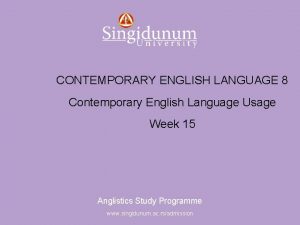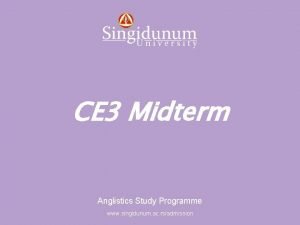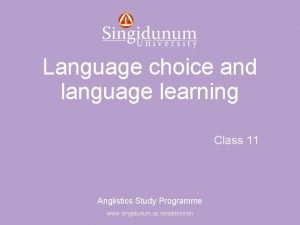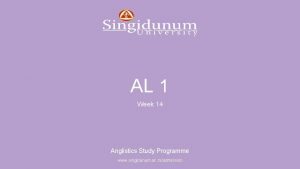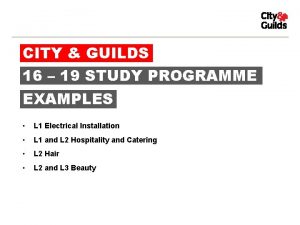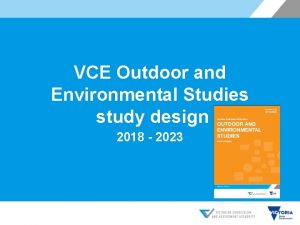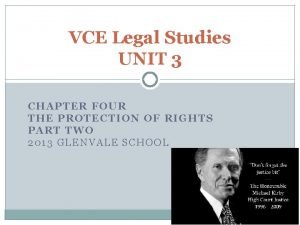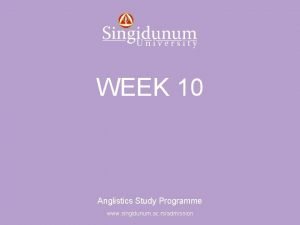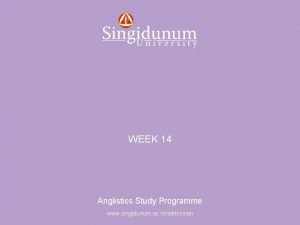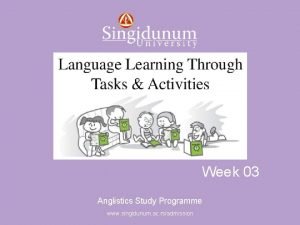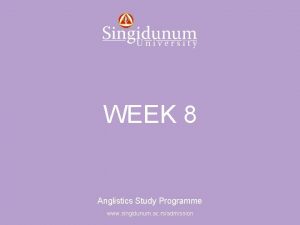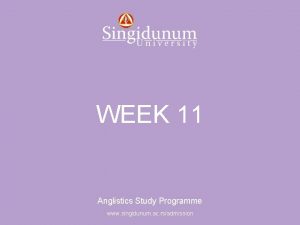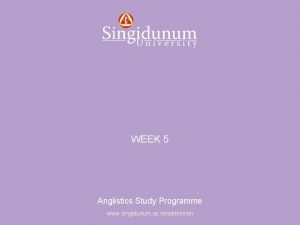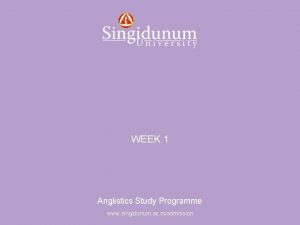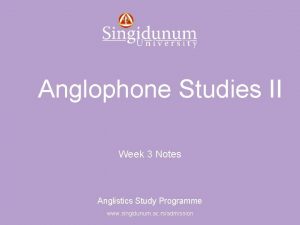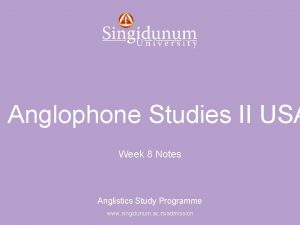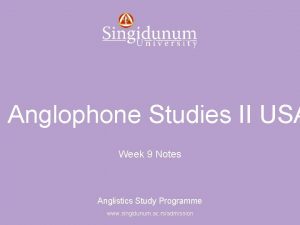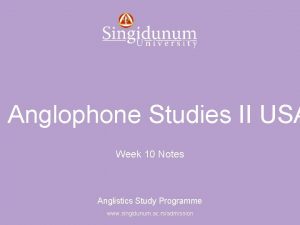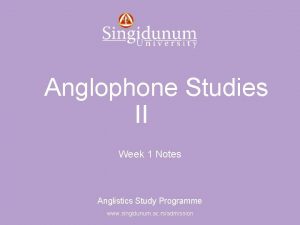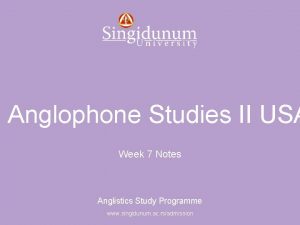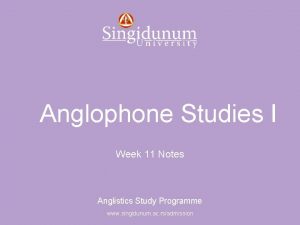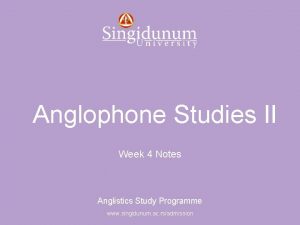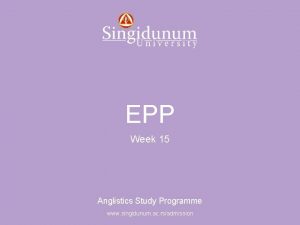Anglistics Study Programme Anglophone Studies IUSA Week 1



















- Slides: 19

Anglistics Study Programme Anglophone Studies I-USA Week 1 Anglistics Study Programme www. singidunum. ac. rs/admission

Anglistics Study Programme Week 1 Notes • Classroom Introductions • Description of Course • Chapter 1: The First “Amerindians” (Native American tribes), page 4 • Chapter 2: Explorers from Europe, page 8

Anglistics Study Programme The First Americans • Christopher Columbus landed October 12 th, 1492, on the island of San Salvador (‘holy savior’)-thinking he had arrived to India, he named the people there Indians • There are many different groups of native “Americans, ” who lived extremely different lifestyles-some hunters, some farmers, some peaceful, some warlike-over 300 separate languages • They had been living there for perhaps 50, 000 years by the time Columbus and his companions had arrived, but we do not know exactly for sure. It is believed that they had arrived from Asia over the Bering Strait during the last ice age, but definitely before a written record had existed.

Anglistics Study Programme The First Americans, contd. • They likely made their way down to the isthmus of Panama 12, 000 years ago, and 5, 000 years ago made it down to the Tierra del Fuego, at the tip of South America • Early Americans lived as hunters and gatherers, and eventually began living a settled way of life starting in the highlands of Mexico, where wild grass had tiny seeds that were edible-these were the continent’s first farmers. They carefully cultivated this wild grass, which grew to become Indian corn, also known as maize. Others eventually appeared-beans, squash, and peppers, for example.

Anglistics Study Programme The First Americans, contd. • The Pueblo of Arizona and New Mexico were the best-organized farmers-lived in groups of villages built for safety on the sides and tops of cliffs-in terraced buildings made of adobe (mud and straw) bricks, dried in the sun-sometimes 800 rooms, crowded one on top ofthe other. They made clothing and blankets from cotton grown in the wild. They wore leather moccasins. They grew crops of beans and corn. They irrigated, built networks of canals to bring water to the dry fields.

Anglistics Study Programme The First Americans, contd. • The Apache were the Pueblo’s neighbors-fierce, warlike, feared, wandered the deserts and mountains in small bands, hunted deer, gathered wild plants, nuts, roots, but also stole food from the Pueblo, raiding them. • The Iroquois were a group of tribes-a nation-lived in the thick woods of northeastern North America-skilled farmers, cleared the forest to grow various crops-hunters and fishermen, used canoes to move along rivers and lakeslived in permanent villages, long wooden huts made of saplings covered by bark-each home held as many as 20 families-each family had its own ‘apartment’-fierce warriorsbuilt strong wooden stockades to protect themselves from enemies-often fought one another-bravery in battle the best way for a warrior to earn respect anda high position

Anglistics Study Programme The First Americans, contd. • The Dakota=the Sioux (meaning ‘enemies’), warriors, lived in the plains between the Mississippi River and the Rocky Mountains, grew no crops, built no houses, depended on buffalo for food, shelter, clothing, followed the buffalo, carried everything wit them, even carried fire, lived in tepees-what we associate as a symbol of the Native American way of life • Lifestyles of the Native Americans differed in the northwest-gathered nuts and berries from the forest, but relied heavily on fish, particularly salmon, and this abundance of food allowed for feasting-tribes like the Haida lived in large houses of wooden planks, and decorated totems

Anglistics Study Programme The First Americans, contd. • A potlatch or a potluck means ‘gift-giving’-the idea where the chief or head of a family would give away everything he owned to show wealthy he was and gain respect-to avoid disgrace, the recipient would have to give it all back and give even more-nowadays, a potluck is a gathering of people and food, in which each guest brings a meal with them to share with everyone

Anglistics Study Programme Explorers from Europe • Prior to the Columbus arrival in 1492, there were legends and stories of others who had arrived to the New World, many of them quite dubious-for example, a Buddhist monk named Hoei-Shin who sailed from China to Mexico in AD 459, or an Irish monk named Brendan the Bold who landed in America in AD 551, or Prince Madoc-a Welsh explorer who allegedly arrived to Mobile Bay in Alabama in 1170

Anglistics Study Programme Explorers from Europe, contd. • Most likely true was that Leif Ericson, Lucky Leif, a Viking from Iceland, arrived to the New World in AD 1, 000, since in the 1960’s traces of Viking settlements were discovered in both Newfoundland (Canada) and New England (northeast USA)-the foundations of huts, as well as iron nails and the whorl (the weight of a spindle), which were clearn examples of their culture since the Native Americans did not know how to make iron until the arrival of the Europeans

Anglistics Study Programme Explorers from Europe, contd. • More Vikings followed but the hostility of the local tribes and the dangerous seas made them give up their attempt to colonize the new world, and it was eventually forgotten • Not until the Spanish did a lasting European occupation of America happen-50 years after Columbus, thousands of Spanish came looking for gold, like Hernan Cortez in the 1520’s among the Aztecs in Mexico, or Francisco Pizarro among the Incas of Peru in the 1530’s

Anglistics Study Programme Explorers from Europe, contd. • Hernando de Soto and Francisco Coronado explored much of the southern part of the U. S. between 1539 and 1541, working separately. After de Soto landed in Florida from Cuba, he continued westward, discovered the Mississippi River, traveled into Texas and Oklahoma. Coronado looked for the Seven Cities of Golddidn’t find them-but became the first Europeans to see the Grand Canyon

Anglistics Study Programme Explorers from Europe, contd. • America was named after Amerigo Vespucci, an Italian sailor from Florence who described his exploration voyages taken along the coast of South America, convinced it was a new continent, in the late 1490’s-a German scholar found his letter, and made his name feminine-just like Asia or Africa • The Fountain of Youth-did not exist, but Europeans felt America was a land of marvels in the 16 th century -Ponce de Leon tried to find it, landed in Florida, never did find it but claimed Florida for Spain. St. Augustine was founded in 1565 -the first permanent European settlement in North America

Anglistics Study Programme Explorers from Europe, contd. • Spain got a large chunk of land in North America, thanks to de Soto, Coronado and others-by 1609, they had founded New Mexico-their wealth made other European nations jealous, and they wanted a piece of the pie for themselves • In 1497, King Henry VII of England hired Italian sailor John Cabot to explore new lands, look for passage to Asia again-he ended up by Newfoundland, and thought it was China at first. The second time around he went as far as Chesapeake Bay-found no gold, no passage to the East, but his voyages helped support England’s claims to own most of the east coast of North America

Anglistics Study Programme Explorers from Europe, contd. • In 1524, the French king Francis I sent the Italian sailor Giovanni Verrazano for the same purpose-to find lands rich in gold, find a new route to Asia, he sailed all along the east coast of America but found neither, but anchored his ship in the harbor of New York • A fisherman from Normandy named Jacques Cartier discovered the St. Lawrence river, talked about the fur bearing animals and the waters full of fish, ended up reaching Montreal and that gave the French a claim to Canada

Anglistics Study Programme Explorers from Europe, contd. • Claiming you own the land is not the same as actually making it your own-this would be done by establishing settlements • By the 17 th century, lots of people in Europe were ready to go and live in America, hopefully to get rich or otherwise escape from political or religious persecution. In the hundred years after 1600, Europeans set up many colonies in North America for these reasons

Anglistics Study Programme Recommended Audiovisual Resources for Week 1 The New World 1492 Pocahontas

Anglistics Study Programme • https: //www. youtube. com/watch? v=Pu. VRMj. ZL P-4 • 25 Little Known Facts About Native Americans

Anglistics Study Programme
 Anglophone caribbean
Anglophone caribbean Powerschool.nbed
Powerschool.nbed Anglophone south school district
Anglophone south school district Anglistics
Anglistics Anglistics
Anglistics Anglistics
Anglistics Anglistics
Anglistics Week by week plans for documenting children's development
Week by week plans for documenting children's development Paradigm shift from women studies to gender studies
Paradigm shift from women studies to gender studies Study programme example
Study programme example Outdoor ed study design
Outdoor ed study design Vce legal studies study design
Vce legal studies study design Drama vce study design
Drama vce study design What is case series
What is case series Retrospective cohort study
Retrospective cohort study Method study in management
Method study in management Study less study smart
Study less study smart Phytogeographical regions of india map
Phytogeographical regions of india map Time study meaning
Time study meaning Distinguish between time study and motion study
Distinguish between time study and motion study



